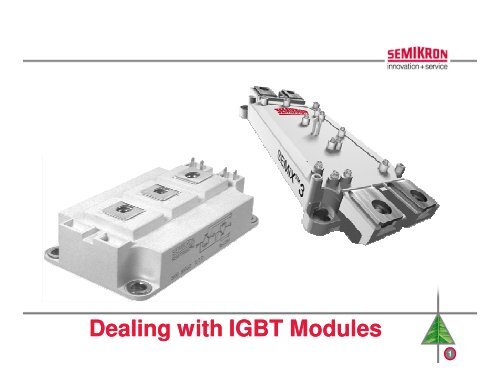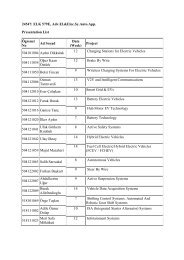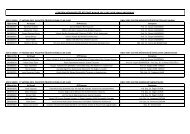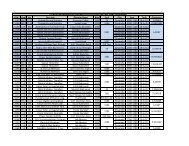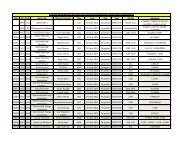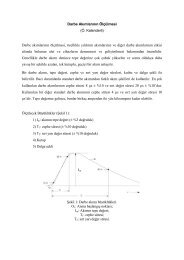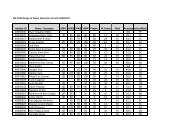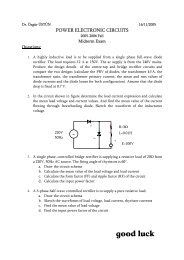Dealing with IGBT Modules
Dealing with IGBT Modules
Dealing with IGBT Modules
You also want an ePaper? Increase the reach of your titles
YUMPU automatically turns print PDFs into web optimized ePapers that Google loves.
<strong>Dealing</strong> <strong>with</strong> <strong>IGBT</strong> <strong>Modules</strong>1
<strong>Dealing</strong> <strong>with</strong> <strong>IGBT</strong> <strong>Modules</strong> Motivation Low inductive DC-link design Choice of right Snubber Gate Clamping Thermal management Paralleling – Application of driver circuit Paralleling – Low inductive AC-Terminal connection Usage of single switch “GA” type modules ConclusionTable of Contents2
<strong>Dealing</strong> <strong>with</strong> <strong>IGBT</strong> <strong>Modules</strong> Motivation Low inductive DC-link design Choice of right Snubber Gate Clamping Thermal management Paralleling – Application of driver circuit Paralleling – Low inductive AC-Terminal connection Usage of single switch “GA” type modules ConclusionTable of Contents3
v CE (t)i C (t)0V CCi Cv CE( )p v (t)I O00t1t2ttpv=EswitchiC⋅vCEt2 p t= ∫v⋅t1dtDependence of V CE , I C , P v , E switch4
Increased switching speed, decreases the switching lossesE switch But, leads to increased di/dt and there<strong>with</strong> to higher overvoltagesv= −v CE (t)i C (t) V CCv CE (t)i C (t) V CCLstray×dditI O0I O0di/dtp v (t)tp v (t)tE switch0t1E switcht2t0t1t2tInfluence of switching speeds5
Would you usethese different vehicles <strong>with</strong>the same driver and inthe same environment?Porsche Diesel - 1960Porsche 911 - 2004Motivation6
<strong>Dealing</strong> <strong>with</strong> <strong>IGBT</strong> <strong>Modules</strong> Motivation Low inductive DC-link design Choice of right Snubber Gate Clamping Thermal management Paralleling – Application of driver circuit Paralleling – Low inductive AC-Terminal connection Usage of single switch “GA” type modules ConclusionTable of Contents7
Why low inductive DC-link design? Due to stray inductances in the DC link, voltage overshoots occurduring switch off of the <strong>IGBT</strong>:vovershoot = Lstray× These voltage overshoots may destroy the <strong>IGBT</strong> module because theyare added to the DC-link voltage and may lead to V CE > V CEmaxdidtvCE= vovershoot+vDC−link With low inductive DC-Link design (small L stray ) thesevoltage overshoots can be reduced significantly.Motivation8
The comparison of stray inductances show Inside the module SEMIKRON reduced the inductances significantlyL stray = 20 nH Outside the module the reduction of stray inductances is necessary, tooL stray = 100 nHLow Inductance DC-link Design9
The mechanical design has a significant influence on thestray inductance of the DC-link The conductors must be paralleledL stray = 100 %loop1 cm² ≈ 10 nHL stray < 20 %Low Inductance DC-link Design10
The mechanical design has a significant influence on thestray inductance of the DC-link The connections must be in line <strong>with</strong> the main current flowL stray = 100 %remaining loopL stray = 30 %Low Inductance DC-link Design11
The mechanical design has a significant influence on thestray inductance of the DC-link Also the orientation must be taken into regardL stray = 100 %+ -+ -L stray = 80 %Low Inductance DC-link Design12
Simulation of current distributionfor the case of L stray = 80 %+ bus bar - bus barLow Inductance DC-link Design13
The mechanical design has a significant influence on thestray inductance of the DC-link A paralleling of the capacitors reduces the inductance furtherL stray = 100 %L stray = 50 %Low Inductance DC-link Design14
For paralleling standard modules a minimum requirement isDC-link design <strong>with</strong> two paralleled barsLow Inductance DC-link Design15
Low Inductance DC-link Design16
Paralleled half bridge <strong>IGBT</strong> modules~-+-+Low Inductance DC-link Design17
FanDC-linkDriverSnubberCapacitor3 x2 x <strong>IGBT</strong> parallelAppleHeat SinkSEMIKRON 3 Phase and Low Inductance Inverter18
Comparison of different designs Two capacitors in series Two serial capacitors in parallelTypical solutionLow inductive solution2 <strong>IGBT</strong> Moduls2 <strong>IGBT</strong> Modulsloop++-+- --++-+---+++---+-++-parallelcurrent pathsCapacitorCapacitorLow Inductance DC-link Design19
Also the capacitors have to be decided Capacitors <strong>with</strong> different internal stray inductance are available Choose a capacitor <strong>with</strong> very low stray inductance! Further: low “ESR” Equivalent Series Resistance High “I R ” Ripple Current CapabilityL stray = ?Ask your supplier!Low Inductance DC-link Capacitors20
<strong>Dealing</strong> <strong>with</strong> <strong>IGBT</strong> <strong>Modules</strong> Motivation Low inductive DC-link design Choice of right Snubber Gate Clamping Thermal management Paralleling – Application of driver circuit Paralleling – Low inductive AC-Terminal connection Usage of single switch “GA” type modules ConclusionTable of Contents21
Why use a snubber? Due to stray inductances in the DC link, voltage overshoots occurduring switch off of the <strong>IGBT</strong>:vovershoot = Lstray× These voltage overshoots may destroy the <strong>IGBT</strong> module because theyare added to the DC-link voltage and may lead to V CE > V CEmaxdidtvCE= vovershoot+vDC−link The snubber works as a low pass filter and “takes over” thevoltage overshoot (caused by the energy which is stored inthe stray inductances)Motivation22
Different snubber networks are in usea) b) c) d)Snubber Networks23
SEMIKRON recommends for <strong>IGBT</strong> applications: Fast and high voltage film capacitor (“MKP” / “MFP”) as snubberparallel to the DC terminalsDC-linkSnubber Not to increase L stray , the snubber must be located directly atterminals of the <strong>IGBT</strong> moduleSnubber Networks24
But still: the snubber networks need to be optimised The wrong snubber does not reduce the voltage overshoots Together <strong>with</strong> the stray inductance of the DC-link oscillations canoccur<strong>IGBT</strong> switch off(raise of V CE )before optimisationVoltage overshootOscillationNot Sufficient Snubber Capacitors25
Influence of DC-link stray inductance and snubber capacitorstray inductanceΔV L di∆VV 2DC∆V 1dtVCE1 stray snubber C= ×<strong>IGBT</strong>-switch-of f .xls−ΔVL1stray snubber di dt−=CLΔV ×2 stray DC bus2 −= C−snubberi2CΔV2L 2×bus=stray DC− −iC2Csnubber00t i C = operating current di C /dt = turn offDetermination of a snubber capacitor26
These capacitors did not work satisfactory as snubber:Not Sufficient Snubber Capacitors27
From different suppliers different snubber capacitors areavailable. In a “trial and error” process the optimum can be find, basedon measurements. The different snubber capacitors have different strayinductance values. Again it is necessary to find one <strong>with</strong>lowest inductance.goodbetterAvailable Snubber Capacitors28
After introduction of optimised snubber capacitor: Significantly reduced voltage overshoots No oscillations<strong>IGBT</strong> switch off(raise of V CE )after optimisationVoltage overshootNo oscillationOptimal Snubber Capacitor29
<strong>Dealing</strong> <strong>with</strong> <strong>IGBT</strong> <strong>Modules</strong> Motivation Low inductive DC-link design Choice of right Snubber Gate Clamping Thermal management Paralleling – Application of driver circuit Paralleling – Low inductive AC-Terminal connection Usage of single switch “GA” type modules ConclusionTable of Contents30
Over voltages at the gate V GE > +/- 20 V can occur due to Induction at stray inductances Burst impulses by EMC-20 V ≤ V GE ≤ +20 V The introduction of an additional gate clamping isnecessary Close to the gate terminals, what means ≤ 5 cm Use twisted pair wiringGate Clamping31
Gate clamping <strong>with</strong> “R GE ” from gate to emitter potential Keeps gate potential always on defined level – also when supplyvoltage of the driver drops Prevents charging of the gate, for highly resistive driver outputs Only R GE is not sufficient for gate clamping. (See the following charts.)V GEGate Clamping32
Gate clamping <strong>with</strong> “Schottky Diode” from gate to supplyvoltage of driver On driver board (distance to module ≤ 5 cm, twisted pair wires) Additional “R GE “ is recommendedV + supplyV GEGate Clamping33
Gate clamping <strong>with</strong> “Zener Diode” or “Avalanche Diode”from gate to emitter potential On driver board (distance to module ≤ 5 cm, twisted pair wires) Or on auxiliary PCB Parallel “R GE “ is recommendedV GEGate Clamping34
Auxiliary PCB directly at the <strong>IGBT</strong> module The additional R GE ensures off-state of <strong>IGBT</strong> in case of failed wiringZ-diodeR GEZ-diodeR GER GoffR GonR GoffR GonGate Clamping35
<strong>Dealing</strong> <strong>with</strong> <strong>IGBT</strong> <strong>Modules</strong> Motivation Low inductive DC-link design Choice of right Snubber Gate Clamping Thermal management Paralleling – Application of driver circuit Paralleling – Low inductive AC-Terminal connection Usage of single switch “GA” type modules ConclusionTable of Contents36
Taking thermal management into regard No space between the paralleled modules lead to low strayinductances and minimum space But the thermal stacking makes a current derating necessaryThermal Management37
20 – 30 mm space between the modules increase the inductances but reduces the thermal resistance to the heat sink significantly Optimised thermal management leads to maximum possiblecurrent ratingsThermal Management38
<strong>Dealing</strong> <strong>with</strong> <strong>IGBT</strong> <strong>Modules</strong> Motivation Low inductive DC-link design Choice of right Snubber Gate Clamping Thermal management Paralleling – Application of driver circuit Paralleling – Low inductive AC-Terminal connection Usage of single switch “GA” type modules ConclusionTable of Contents39
Different <strong>IGBT</strong> modules <strong>with</strong> different Switching speeds t on and t off Gate thershold voltages V GE(th) Gate charge characteristic V GE = f(Q G ) and „Miller Capacity“ C res Transfer characteristic I C = f(V GE )CGAEV GE V GE V GEEDue to hard connected gates, all <strong>IGBT</strong>s must have the same V GEThis means: all <strong>IGBT</strong>s do not switch independently from each otherWorst Case: All Contacts Shorted40
Hard connected Gates All <strong>IGBT</strong>s have different gate threshold voltages ∆ V GE(th) <strong>IGBT</strong>1, <strong>with</strong> the lowest V GE(th) turns on first. The gate voltage is clamped to the Miller-Plateau. Therefore <strong>IGBT</strong>’s<strong>with</strong> higher V GE(th) can not turn on. They turn on only after ∆t 1 . The <strong>IGBT</strong>1 <strong>with</strong> low V GE(th) takes all the current and switching lossesduring turn on. On going process by negative thermal coefficient of V GE(th)V GE∆V GE(th)tt∆t 1 1∆t 1 nHard Connected Gate <strong>with</strong> Common Resistor41
Separated by gate resistors The gate voltage of each <strong>IGBT</strong> can rise independent from the otherone. Note: The gate resistors must be tolerated < 1 %CGAEV GE 1V GE 2V GE nEWith individual gate resistors all <strong>IGBT</strong>s are independent from each otherIntroduction of Gate Resistors42
Separated by gate resistors All <strong>IGBT</strong>s still have different gate threshold voltages ∆V GE(th) But: The gate voltage of each <strong>IGBT</strong> can rise independently from the other ones. The higher Miller-Plateau will be reached after a short time ∆t 1 . Only smalldifferences in current sharing and switching losses between paralleled <strong>IGBT</strong>s.V GE∆V GE(th)∆t 1t∆t 2Introduction of Gate Resistors43
Taking stray inductances into regard Due to hard connected gates and varying transfer characteristics, all <strong>IGBT</strong>shave different switching times and speeds; di x /dt varies in each leg The circuit also has different stray inductances; L x There<strong>with</strong> v x = L x x di x /dt varies in each leg (e.g.: 1000 A/µs x 10 nH = 10 V) Nearly unlimited equalising currents i flow also via the thin connecting wires Oscillations between parasitic capacitances (semiconductors) and -inductances are not damped.CGAEi = ∞V 1 V 2 V nEWorst Case: All Contacts Shorted44
The introduction of R Ex (≈ 10 % of R Gx but min. 0,5 Ω) leads to Limitation of equalising currents i ≤ 10 A Damping of oscillationsCGR E1R E2R EnAEi ≤ 10 AV 1 V 2 V nEIntroduction of Auxiliary Emitter Resistors45
The introduction of R Ex leads also to a negative feedback: The equalising current i leads to a voltage drop V REx at the Emitterresistors R ExCfast <strong>IGBT</strong>slow <strong>IGBT</strong>GAEV RE1V RE2iEIntroduction of Auxiliary Emitter Resistors46
The introduction of R Ex leads also to a negative feedback: The voltage drop V RE1 reduces the gate voltage of the fast <strong>IGBT</strong> anddecreases there<strong>with</strong> its switching speed. The voltage drop V RE2 increases the gate voltage of the slow <strong>IGBT</strong> andmakes it faster. During switch off: vice versa.fast <strong>IGBT</strong>Cslow <strong>IGBT</strong>GAEV RE1iV RE2EIntroduction of Auxiliary Emitter Resistors47
The introduction of Shottky-Diodes parallel to R Ex helps to balance the emitter voltage during short circuit case. Dimensioning ≈ 100V, 1A.Additional ProposalsThis circuit is patented by SEMIKRON,but SEMIKRON customers are allowed to use it together <strong>with</strong> SEMIKRON power semiconductor modules.48
The introduction of clamping diodes prevents over voltages at the gate contacts. Therefore these clamping diodes must be placed very close to the moduleconnectorsCGAEEAdditional Proposals49
Balanced switching behaviour Independent switching due to introduction of R Gx Balanced switching speeds due to negative feedback be introduction of R Ex Limitation of equalising currents Damping of oscillations Prevention of gate over voltages Refer also to “SEMIKRON Application Manual - Power <strong>Modules</strong>” German English Chinese Korean Japanese Russian (on internet only)Conclusion50
PCB for paralleling <strong>IGBT</strong> close to the module connectors Same track length on the board Short, twisted pair wires from the board to the modules (≤ 5 cm)R GonR GonR GoffR GoffR E R GoffR ER ER GonR ER GoffR GonAdditional Parallel Board51
Top Bot<strong>IGBT</strong> DriverAdditional Parallel Board52
Auxiliary PCB directly at the <strong>IGBT</strong> module The additional R GE ensures off-state of <strong>IGBT</strong> in case of failed wiring Same track length on the board Short, twisted pair wires from the main driver to the auxiliary PCB at the<strong>IGBT</strong> moduleZ-diodeR GEZ-diodeR GER ER GoffR GonR ER GoffR GonAuxiliary Printed Circuit Board53
<strong>Dealing</strong> <strong>with</strong> <strong>IGBT</strong> <strong>Modules</strong> Motivation Low inductive DC-link design Choice of right Snubber Gate Clamping Thermal management Paralleling – Application of driver circuit Paralleling – Low inductive AC-Terminal connection Usage of single switch “GA” type modules ConclusionTable of Contents54
Why symmetrical AC terminal connection for paralleled <strong>IGBT</strong>s? When the connection between the AC terminals have high inductance anddifferent inductances, the current sharing of I C (output current) will beinhomogeneous and oscillations may occur. This would make a current derating necessary.Simulation of 4paralleled <strong>IGBT</strong>modules <strong>with</strong>inhomogeneouscurrent sharingleads to oscillations200.0I C150.0100.050.00-50.00 10.00u 20.00u 30.00u 40.00u 50.00utMotivation55
Why symmetrical AC terminal connection for paralleled <strong>IGBT</strong>s? The sketch shows that L stray,DC and L stray,AC are connected in series This makes clear why both have to be reduced and both have to besymmetric in each leg to ensure even current distribution to avoid oscillationsCGESymmetrical AC Connection56
AC link design Short connections <strong>with</strong> identical current path length for each module Wide and thick bars Flexible interconnections for large systems might be necessary tocompensate differences in thermal expansion ‘Long hole drillings' can compensate mechanical tolerances Isolated supporting polestake over vibrations andforces from heavy AC cables Look for a symmetric AC-connection so that the currentsharing will be even over all modulesSymmetrical AC Connection57
<strong>Dealing</strong> <strong>with</strong> <strong>IGBT</strong> <strong>Modules</strong> Motivation Low inductive DC-link design Choice of right Snubber Gate Clamping Thermal management Paralleling – Application of driver circuit Paralleling – Low inductive AC-Terminal connection Usage of single switch “GA” type modules ConclusionTable of Contents58
Optimisation problem In order to optimise the thermal management it seems to be be usefulsplitting the current of one half bridge topology into two modules. The question is: what is better – use two paralleled half bridges, or twosingle switches in series connection?1+11+33~?21~22-2-Motivation59
How to parallel half bridge <strong>IGBT</strong> modules++111 133~-2 2223 3-~Paralleling of GB modules60
How to use single switch <strong>IGBT</strong> modules as half bridge+1+-21~12212-~Paralleling of GA modules61
Increased switching speed, decreases the switching lossesE switch But, leads to increased di/dt and there<strong>with</strong> to higher overvoltagesv CE (t)i C (t) V CCv CE (t)i C (t) V CCv Ls = − tray ×dtdiI O0I O0di/dtp v (t)tp v (t)tE switch0t1E switcht2t0t1t2tInfluence of switching speeds62
Comparison For GB modules the diodes for commutation are placed in the samemodule. There<strong>with</strong> the stray inductance is as low as possible. Paralleled GB modules allow higher switching speeds1+1+-1233~212-2~GA or GB?63
Comparison In half bridge modules the snubber capacitors can be placed closed tothe terminals <strong>with</strong> short - and there<strong>with</strong> low inductive connections. Sothat the snubbers work very efficient. Paralleled GB modules allow higher switching speedsGA or GB?64
Advantages of paralleled half bridges The current per module is only 50 % of the maximum current The di/dt is much reduced, there<strong>with</strong> the voltage overshoot is small(v = - L x di/dt) The half bridge module has much lower stray inductances, what reduces thevoltage overshoot again Snubber capacitors can be placed very close to the terminals, so that theywork very efficient The switching speed can be increased and there<strong>with</strong> the switching lossesare reduced SEMIKRON recommends the use of paralleled half bridgemodules instead of single switch modulesConclusion65
SEMIKRONs recommended solution66
<strong>Dealing</strong> <strong>with</strong> <strong>IGBT</strong> <strong>Modules</strong> Motivation Low inductive DC-link design Choice of right Snubber Gate Clamping Thermal management Paralleling – Application of driver circuit Paralleling – Low inductive AC-Terminal connection Usage of single switch “GA” type modules ConclusionTable of Contents67
<strong>Dealing</strong> <strong>with</strong> <strong>IGBT</strong> <strong>Modules</strong> When using latest generations of<strong>IGBT</strong> modules it is recommended andadvantageous to Do a low inductive (“sandwich”) DC-linkdesign Decide for low inductive DC-link capacitors Optimise the snubber capacitors Optimise thermal management whichleads to maximum possible current ratingsConclusion68
<strong>Dealing</strong> <strong>with</strong> <strong>IGBT</strong> <strong>Modules</strong> For paralleled modules The driver must be powerful enough Some additional components arenecessary (e.g. R Ex ) and must belocated close to every single module The DC- and AC connection must besymmetric and low inductiveConclusion69
Thank you very much for your attention Refer also to “SEMIKRON Application Manual - Power <strong>Modules</strong>”70
Document status:preliminaryDate of publication: 2006-04-04Revision: 1.3Prepared by:Christian DaucherWith assistance fromDr. Arendt WintrichNorbert PluschkeInformation furnished in this document is believed to be accurate and reliable. However, no representation or warranty isgiven and no liability is assumed <strong>with</strong> respect to the accuracy or use of such information. Furthermore, this technicalinformation specifies semiconductor devices but promises no characteristics. No warranty or guarantee expressed orimplied is made regarding delivery, performance or suitability. Specifications mentioned in this document are subject tochange <strong>with</strong>out notice. This document supersedes and replaces all information previously supplied and may besupersede by updates.71
<strong>IGBT</strong> modules are ESD sensitive devices. Thus they will delivered <strong>with</strong> a short circuit connection betweengate terminal and auxiliary emitter terminal Remove this connection and handle the modules only whenit is assured, that the environment is ESD proofAdditional72


